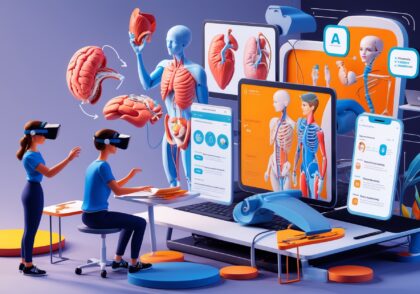Why is learning anatomy important for everyone?
Introduction
Many people believe that anatomy is only important for doctors and medical students, but this is not true. Knowing anatomy can be very useful for everyone, regardless of their job or specialty. Familiarity with the structure of the body helps us to better understand our health, prevent injuries, and better recognize the symptoms of diseases. This article examines the importance of learning anatomy for non-doctors and provides simple and practical methods for learning this science.
Why is learning anatomy important for everyone?
Increasing awareness of personal health
One of the most important reasons for non-medical people to learn anatomy is to increase their awareness of personal health. When we understand how the body works, we can make better decisions to maintain our health. Also, understanding the function of body parts helps us recognize symptoms of diseases earlier and take necessary measures if necessary.
Benefits of knowing anatomy for personal health:
-
- Better understanding the function of internal organs such as the heart, lungs, and digestive system
- Early detection of symptoms of diseases such as diabetes, high blood pressure, and heart problems
- Make better decisions about nutrition, exercise, and a healthy lifestyle
Help prevent injuries and damages
Understanding the structure of the body and how it functions helps prevent everyday injuries. People involved in sports, physical work, and even everyday activities can avoid injuries with a basic knowledge of anatomy.
Examples of how anatomy can help prevent injuries:
-
- Athletes: Understanding muscles and joints to perform sports movements correctly
- Office workers: Prevent back pain by knowing the correct sitting posture
- Mothers and fathers: taking better care of children and preventing injuries caused by incorrect body positions
Better understanding of medical and treatment recommendations
Sometimes when we visit the doctor, we don’t understand the medical terminology and their explanations. Familiarity with basic anatomical concepts helps us understand the doctor’s explanations better and make more informed decisions about our health.
How does knowledge of anatomy help us better understand medical advice?
-
- Better understanding of terms such as muscle strain, hernia, arthritis
- Ability to communicate better with the doctor and ask more specific questions
- Choosing the most appropriate treatment methods and preventing incorrect self-treatment
Key parts of anatomy that everyone should know
Musculoskeletal system
The skeletal and muscular systems form the foundation of body movement. Understanding the components of this system and how they function helps us perform correct movements and prevent physical injuries.
Components of the skeletal system:
-
- Bones: They form the main structure of the body and protect vital organs.
- Joints: They enable body movement and connect bones.
Components of the muscular system:
-
- Skeletal muscles: enable movement of the limbs.
- Smooth muscles: Play a role in internal organs such as the stomach and intestines.
- Heart muscle: It is responsible for pumping blood.
Cardiovascular system
The cardiovascular system is responsible for transporting oxygen and nutrients throughout the body. Understanding how the heart and blood vessels work can help you better understand cardiovascular disease.
Key structures of the cardiovascular system:
-
- Heart: The central blood pump, divided into four main sections (right atrium, left atrium, right ventricle, left ventricle).
- Arteries and veins: Transport blood throughout the body.
- Capillaries: The smallest blood vessels that carry out the exchange of oxygen and nutrients.
Digestive system
This system is responsible for digesting food and absorbing nutrients. Understanding how this system works can help you make healthier diet choices.
Digestion stages:
-
- Mouth and teeth: primary breakdown of food
- Stomach: secretes acids and enzymes to further break down food
- Small intestine: absorption of nutrients
- Large intestine: processing and eliminating waste
روشهای ساده و کاربردی برای یادگیری آناتومی برای افراد غیرپزشک
Using educational apps
Today, with the advancement of technology, learning anatomy has become much easier through educational apps. These apps include 3D models of the human body, simple explanations, and interactive quizzes.
Best educational apps for learning anatomy:
-
- Complete Anatomy: 3D models of body parts with detailed explanations
- Anatomy Learning 3D: Interactive display of body structure
- Visible Body: High-detail body anatomy display
Watch educational videos and documentaries
Educational videos, documentaries, and scientific animations are one of the best ways to learn anatomy in an engaging and simple way.
Benefits of educational videos in learning anatomy:
-
- Visual and understandable representation of body structure
- Reducing the complexity of medical terms
- Possibility to learn anytime, anywhere
Participate in workshops and online courses
Participating in online courses and workshops can be a practical and effective way to learn anatomy.
Characteristics of a useful training course:
-
- Teaching through images and 3D models
- Using fun learning methods to better understand concepts
- Practical exercises to consolidate learning
Conclusion
Learning anatomy is not just essential for doctors and medical students, but it is beneficial for everyone. From better understanding personal health to preventing injuries and better understanding medical advice, anatomy plays a vital role in our daily lives. Fortunately, there are several methods, such as educational apps, scientific videos, and workshops, that make learning this science easier and more engaging for non-medical people. By taking advantage of these resources, anyone can gain a better understanding of their own bodies and make more informed decisions about their health.






Leave a Reply
You must be logged in to post a comment.